News In Slow German

Summary
News in Slow German is one of the most fun resources around. Each week, they release a new 30-minute episode that’s ideal for those with an intermediate level of German. While that may not sound like much content, their grammar and expressions catalogs are massive and can provide countless hours of study materials. The current events part of the program is interesting and the grammar and expressions parts are much more fun than you’d expect, while aging very well. Overall, I was impressed with the natural, engaging, and effective way that they teach German.
An all-around well-designed resource.
Great for intermediate levels, but beginner and advanced students should look elsewhere.
Somewhat expensive, but there’s more content than you initially expect.
I Like
- Using current events to learn German makes studying more interesting.
- Grammar and expressions are taught in a very natural manner that’s actually fun.
- The huge grammar and expressions catalogs provide a ton of extra content.
I Don’t Like
- Their app is very basic so you may prefer using the mobile version instead.
- You’ll want to work with a tutor to get more active speaking practice.
Price
7-day free trial, then $14.90/month. You also have the option to prepay for any amount of months at a time, which doesn’t change the monthly price.
News in Slow German is a resource that offers material that’s especially good for intermediate level learners.
They’ve been releasing a weekly 30-minute episode since 2016 and now offer beginner and intermediate news stories, courses on grammar and expressions, as well as fiction and non-fiction series.
Their episodes are ideal for those with an intermediate level of German who aren’t quite ready for native German materials. Absolute beginners would be better off finding a German course and advanced learners may prefer to find some podcasts to help them get more listening practice.

This review will take a very detailed look at everything that’s included with a subscription to News in Slow German.
Let’s get into it.
News Stories

The intermediate news stories are the heart of News in Slow German. As the name implies, these are current events narrated and discussed at a slower speed, making them much more accessible for those studying German.
The intermediate-level news stories have been around for much longer than those at the beginner level, and so their catalog is much larger. The beginner news stories could make a rare source of interesting material at the level, but it’s probably beyond absolute beginners.
For each of the four news stories, there’s a transcript of the dialogue. You’ll notice that many of the words and phrases are written in red. If you hover over these phrases, you’ll be given an English translation.
Because current events can cover all sorts of challenging topics, this is a super useful resource.
I also like that it’s not only individual words that you can get a translation for. Sometimes you may understand every word in a phrase but still be unclear of that phrase’s meaning. Having translations for full phrases can make things much easier. This is especially helpful at the beginner level.
At the end of the lesson, you’ll get a chance to practice your pronunciation of key phrases from the story.
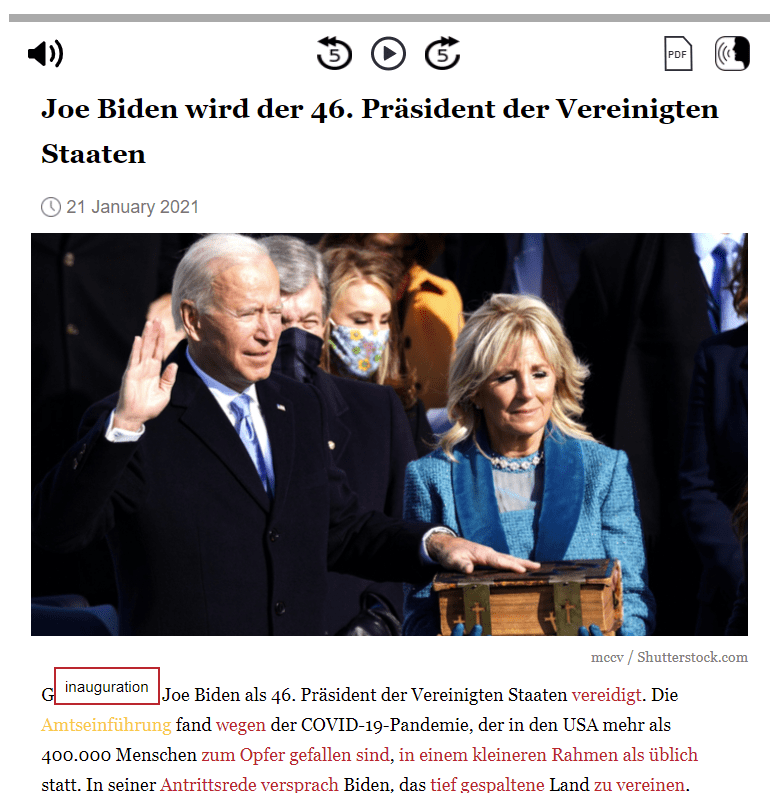
The hosts narrate each news story, discuss it, and add in extra information and their own opinions on the topic.
Each of these news stories lasts around 4 or 5 minutes. They’re interesting, educational, and suitable for those with an intermediate level of German. You can also slow down or speed up the playback speed to best suit your level.
Pronunciation Practice
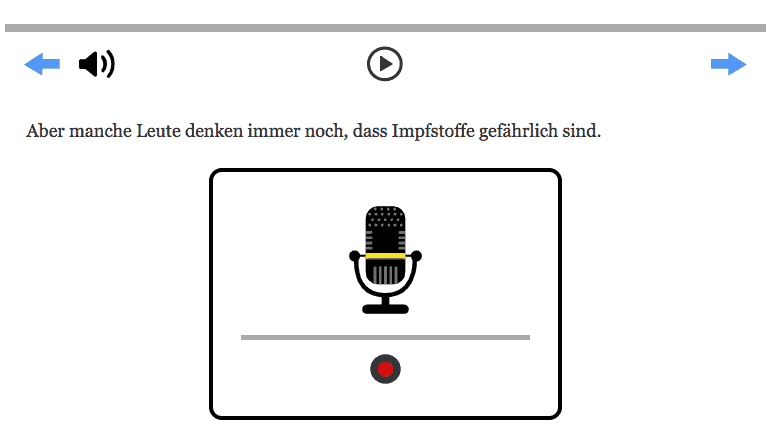
The pronunciation practice is one of the weaker areas of News in Slow German in my opinion, though it’s not entirely their fault.
In this section, you’ll be given a recording of a phrase or sentence and then record yourself mimicking the native German speaker. This is one of the best ways to improve your spoken German, so their heart was really in the right place.
The reason I’m not so excited about it here is that there’s another resource, Speechling, that does this much better. On Speechling, for free, you can record yourself mimicking thousands of sentences recorded by native German speakers. Then, if you’re willing to pay, you can also get feedback on your pronunciation.
Grammar Course
This is where learners can access lessons, dialogues, and quizzes on a wide range of grammar subjects.

Instead of explaining the grammar point in the initial dialogues, the hosts simply discuss interesting topics, which often dig into German culture, society, history, and their experiences. Throughout the discussion, they use the grammar point repeatedly but in a natural context.
Then, if you were to look at the transcript, you would see that each time the grammar point is used, that word or phrase is bolded. You’ll also get more detailed explanations of grammar.
Since the hosts have a natural discussion and the grammar isn’t explicitly taught in the dialogues, the vocabulary can still be somewhat challenging. Being able to check and see translations of the more difficult words and phrases here can be very useful.
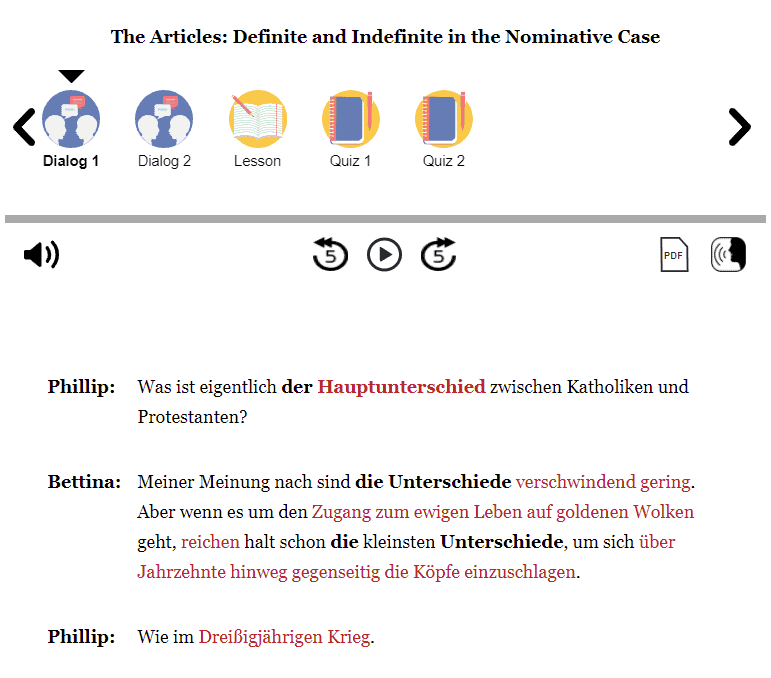
After the grammar dialogues is the grammar lesson. While most of News in Slow German is unique, the grammar lessons are much more traditional. These lessons look like something you’d find in a textbook.
There’s no audio here but rather a written explanation of how the grammar point is used, along with examples.
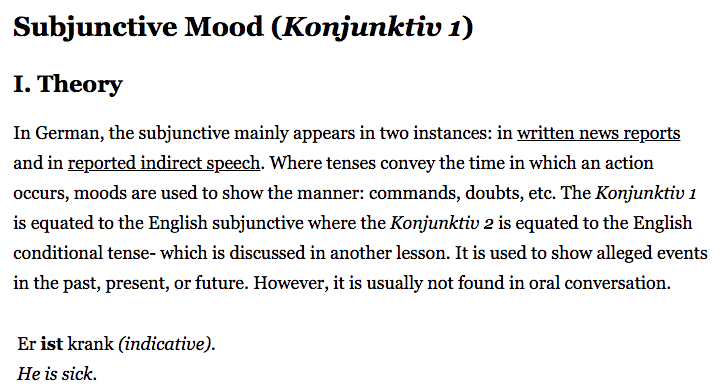
It may not be the most exciting feature, but it’s definitely necessary. This will be a huge help to really understand the grammar.
After the grammar lesson, you’ll come across the related grammar quizzes.
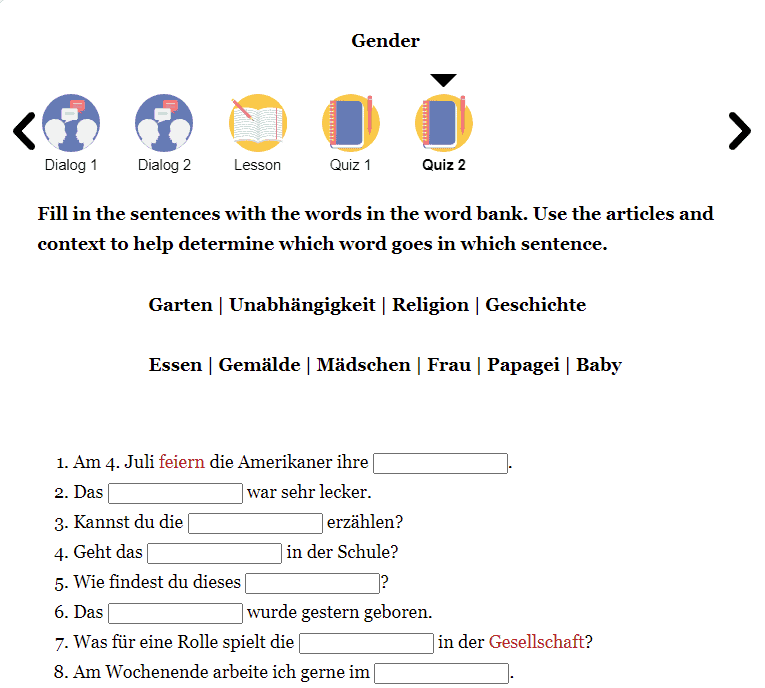
The interactive grammar quizzes are fill-in-the-blank questions related to that episode’s grammar point.
Like the grammar lessons, it may not be the most exciting part of News in Slow German, but it’s still quite useful. In order to master a grammar point, you have to be able to use it yourself. This section helps you learn to do that.
You can also hover your mouse over the words written in red to see translations or click a button to see the answers.
There’s also a huge grammar catalog.
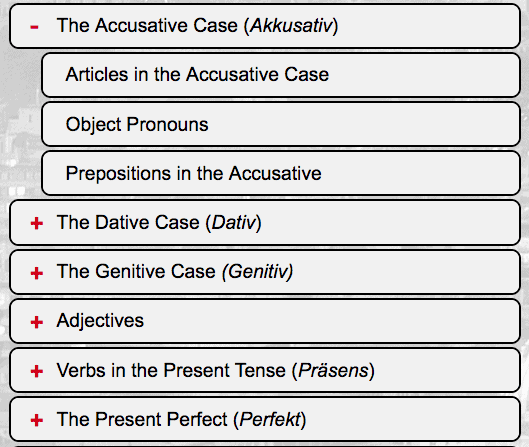
The grammar catalog is something that may be very easy to initially overlook but is actually incredibly valuable.
Because News in Slow German has been releasing a new episode every week for several years, the grammar catalog has become quite large.
I wouldn’t necessarily recommend using this as your sole resource for studying grammar — a textbook would almost certainly have a better structure. However, this is an absurdly good supplemental resource.
Given the nature of the grammar dialogues, where the grammar isn’t actually taught but rather used naturally, the grammar catalog is useful for much more than just studying grammar.
These dialogues discuss a ton of interesting topics and are just as good for improving your listening comprehension, vocabulary, and pretty much everything else as the news stories in the latest episode.
So, even if you have no interest in studying a certain grammar point, you’ll almost certainly find value in listening to the dialogue.
Expressions Course
The expressions course is quite similar to the grammar course. Again, it’s quite useful.

Similar to the grammar section, this part teaches expressions in a sort of indirect manner.
Instead of giving you a translation and then a bunch of sentences that use that expression, News in Slow German takes a much more holistic approach.
The hosts simply have a discussion about some interesting topic which often ends up teaching you about some facet of German culture. Then, several times during this discussion, a situation will come up where it makes perfect sense to use the expression, and that’s when you’ll hear it.
I absolutely love this way of approaching expressions. I think it’s much more effective, enjoyable, and natural than pretty much any other resource I’ve come across.
One interesting note is that sometimes in the expressions lessons, a second expression is used. When that’s the case, you can click on it, taking you to the dialogue and lesson for that expression.
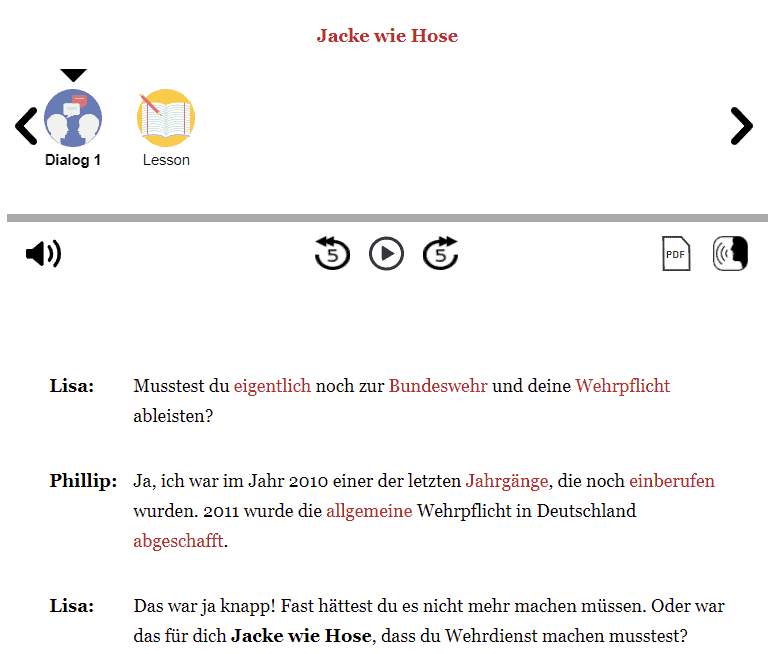
During the expression dialogue, you don’t actually learn about the expression. Instead, it’s used several times in a natural context.
Then, similar to how the grammar lessons don’t include audio, the expressions lessons don’t either. However, this part really doesn’t resemble a textbook in the same way the grammar part does.
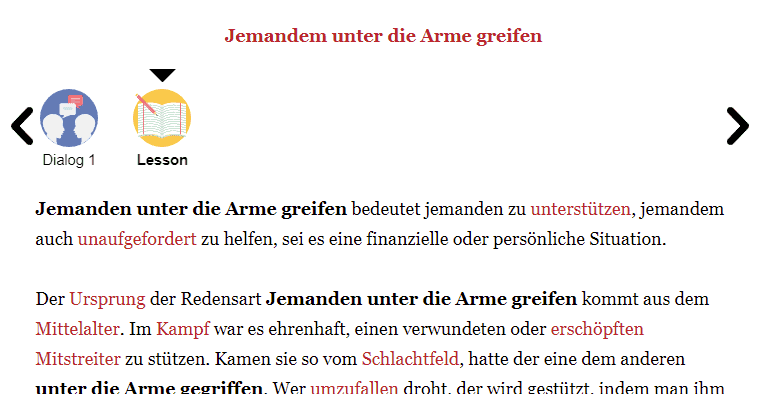
It’s actually very interesting and another part of News in Slow German that I really enjoyed using.
This is where they take the time to explain the expression. It’s written nearly entirely in German with the exception of the translations for some examples.
I really enjoyed how they tell you more about how the expression originated and became commonly used. This can be really interesting.
There’s also a huge catalog of expressions.
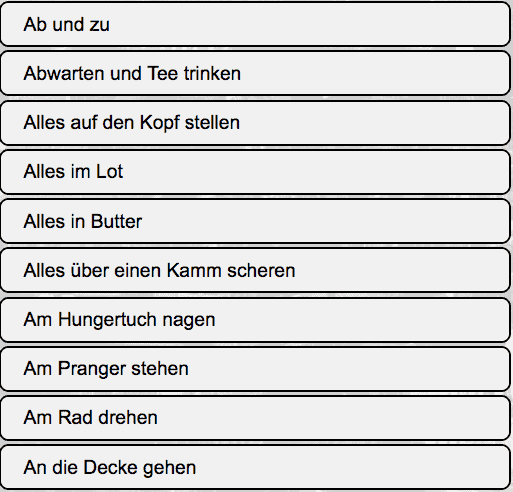
This part of News in Slow German definitely shouldn’t be ignored.
Since the expressions (and grammar) dialogues are just as relevant years after when they were initially recorded, this is a huge library of useful study material.
You can listen to the dialogues and read the lessons of all the expressions that have been created since News in Slow German began. The amount of material available for you to study is really astounding.
Series
They also have a section called “series” which allows you to listen and read along to both fictional and nonfictional stories broken out into different chapters or parts.

These lessons also don’t come with any grammar dialogue, lessons, etc. as many of the other lessons do, so if this is something that you value then you may not want to spend too much time with these.
However, if you are beyond a total beginner and want to study with something that’s a little more entertaining than some of the news content then this section may be worth checking out. The current content ranges from beginner to advanced so you can try it out no matter what your level is.
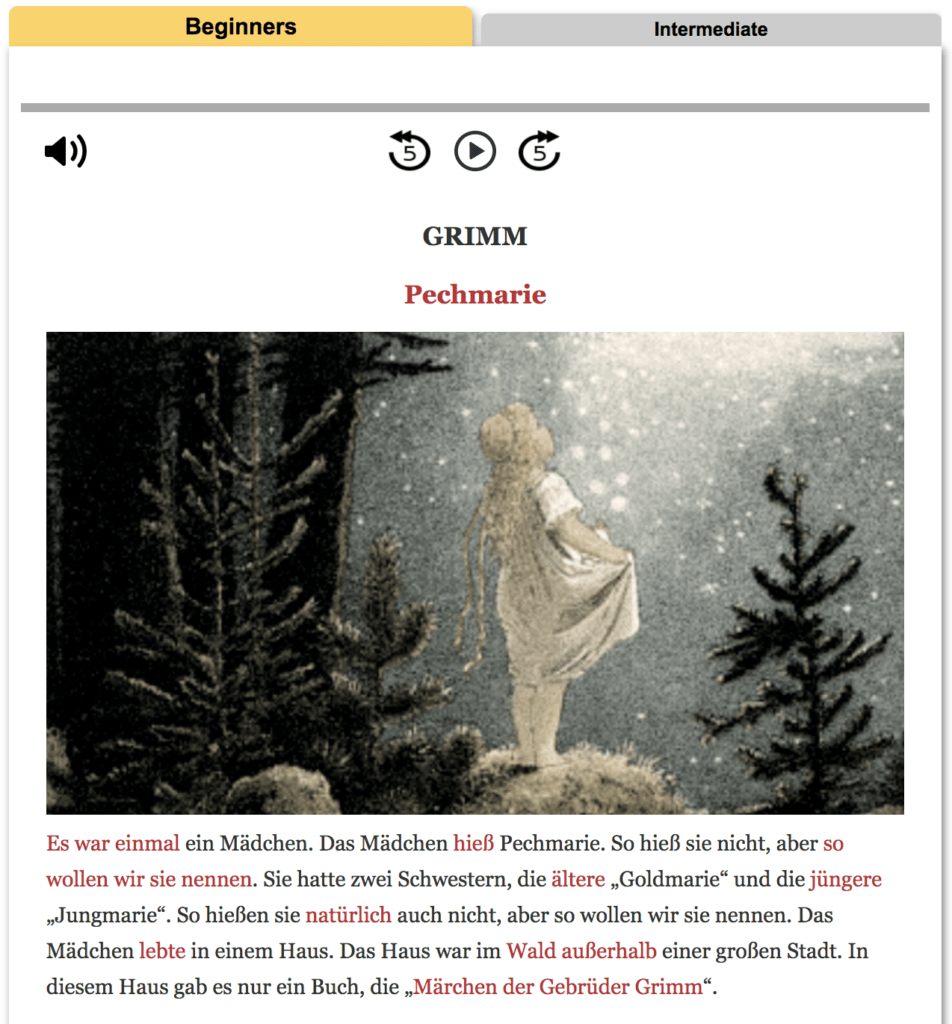
L360 App
This is the app for getting News in Slow German practice on a mobile device. It’s fairly basic, but it contains all of the news stories and series episodes, enables playlist creation, and lets you listen to episodes offline.
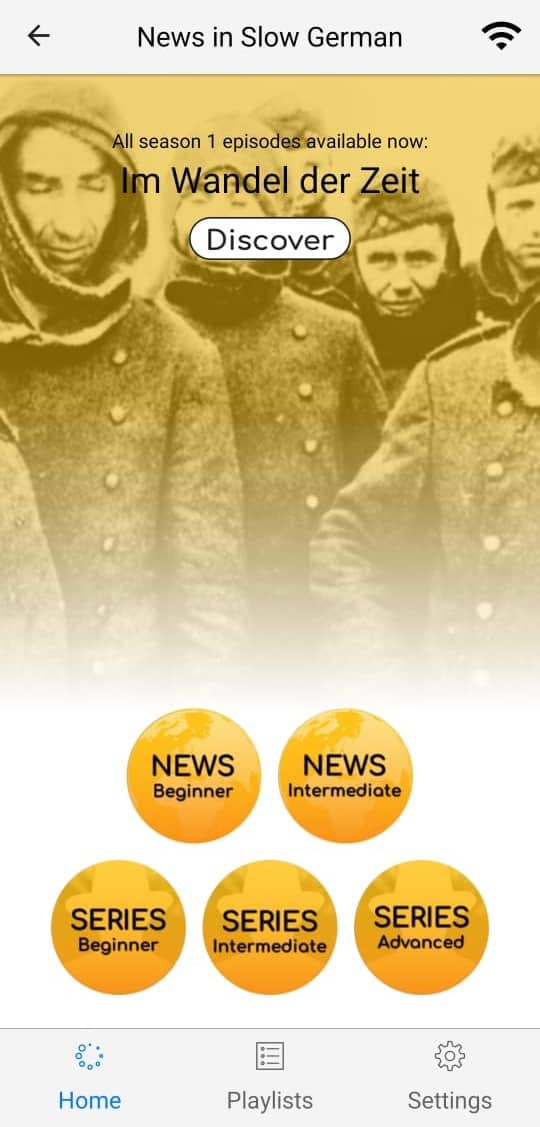
You’ll have to use the browser version of News in Slow German if you want access to its courses, but the app is still a convenient solution for mobile listening.
Pricing
For new subscribers, there’s a 7-day free trial offer, but you’ll need a credit card to sign up. After the seven days, you’ll be automatically be billed $14.90 each month. You can cancel at any time, and you’ll still have access to the program until the end of the billing period.

If you want to avoid a recurring subscription, you have the option of prepaying for up to 12 months at a time. There isn’t a discount for doing so, but you won’t have to worry about forgetting to cancel your subscription.
Final Thoughts
I really enjoyed using News in Slow German. They manage to do everything really well.
It’s rare for a resource to be as much fun to use without sacrificing quality and effectiveness. I love the way they teach grammar and expressions as it feels very natural, making it easier to internalize how both are used.
Some resources, like GermanPod101, try to emphasize just how many features they have when many of them aren’t at all useful. With News in Slow German, everything serves a purpose. It’s an impressively well-thought-out resource that is actually fun to use.

